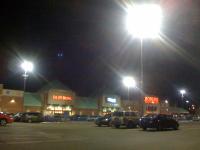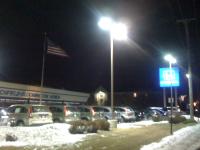Wed 2 Apr 2008
I-494 Light-Pollution Problems
Posted by admin under I-494
Comments Off on I-494 Light-Pollution Problems
Night after night, the one problem on 76th Street, that is very clear is the amount of light pollution and light trespassing (which occurs when unwanted light enters one’s property) from the businesses and heavily light roadways along the 494 corridor.
I can remember a time in the early 1970s when there wasn’t a greyish glow coming from 494. But that was when before the Honda car dealership and when the Colonial Motel occupied the spot of where the four story Hampton Inn is now. The brightest things at the Colonial Motel were the entryway lights on each of the cottages. I think they may of had a flood light pointing at a sign but I don’t recall it ever working.  If you go across Lyndale Avenue, the light pollution created by lighting at “The Shops at Lyndale” big box retail center is surpassed only by the light pollution created by the city. While I am very happy to see the development and a revitalised business corridor there, the bright glare coming from the over-lit buildings and the parking lots has little to do with security and is more about competitive brightness and marketing.  So what is the limit on brightness? If none, will lights just keep getting brighter and brighter in retailers crazy attempts to lure consumers? A quick google search with the words “light pollution big box retail” helped me realize my neighborhood was not the only one dealing with this problem. The issues facing Richfield about light pollution and light trespassing are not unique to us but are part of a much larger nationwide issue. While many communities oppose the idea of big box retail out of principle, others simply take issue with the effects that big box usually bring including light pollution, but also the problems of traffic, water quality/run off, safety issues etc… Richfield, I suppect is of the latter.
If you go across Lyndale Avenue, the light pollution created by lighting at “The Shops at Lyndale” big box retail center is surpassed only by the light pollution created by the city. While I am very happy to see the development and a revitalised business corridor there, the bright glare coming from the over-lit buildings and the parking lots has little to do with security and is more about competitive brightness and marketing.  So what is the limit on brightness? If none, will lights just keep getting brighter and brighter in retailers crazy attempts to lure consumers? A quick google search with the words “light pollution big box retail” helped me realize my neighborhood was not the only one dealing with this problem. The issues facing Richfield about light pollution and light trespassing are not unique to us but are part of a much larger nationwide issue. While many communities oppose the idea of big box retail out of principle, others simply take issue with the effects that big box usually bring including light pollution, but also the problems of traffic, water quality/run off, safety issues etc… Richfield, I suppect is of the latter.  From what I have read on the web, communities like Richfield, that have been retrofited for big box retail seem to have the biggest issues. That is probably because in a new development you have more of an opportunity to develop away from residential, in a community retrofitted with big box retail, as in the case of “Shops on Lyndale” that may be impossible.However, what really worries me is not so much the current situation but rather the increasing brightness and glare that will come with future development.
 From what I have read on the web, communities like Richfield, that have been retrofited for big box retail seem to have the biggest issues. That is probably because in a new development you have more of an opportunity to develop away from residential, in a community retrofitted with big box retail, as in the case of “Shops on Lyndale” that may be impossible.However, what really worries me is not so much the current situation but rather the increasing brightness and glare that will come with future development.
The other light polluting culprits nearby appear to be hotels and car dealerships. The hotels nearby 76th Street are not much of a problem -understandably as they have an insentive to keep their lighting low key. However there appears to be little insentive for car dealers to change. For car dealerships crime and vandalism are big part of the reason for turning night into day in their lots. Other options, such as storing cars inside would be too costly for most. However, for big box retail it appears to be more of a mindset. As mentioned in the Globe and Mail:
No one seems to like high lighting levels more than big-box retailers. Many now use three times the intensity of shopping-mall lighting in the 1970s.”There is a lot of desire to boost up the light levels,” said TonyRutenberg, sales manager at Rutenberg Sales Ltd. of Mississauga, a majorCanadian lighting dealer. “It looks very inviting.” The big-box retailer thinks, ” ‘I’m going to have more people come in,’ ” he said.~Blinded by the light, Globe and Mail http://www.globeandmail.com Â
 Much of these problems could be dealt with. Fortunately, light trespass is easily controlled by using full cut-off fixtures and reasonable illumination levels. Full cut-off fixtures keep the light down on the ground, where it is needed, instead of being cast to the side or in the sky, where it is wasted.Lights recessed into gas station canopies instead of mounted on the surface (which is typical throughout Richfield) is a good example of how to control light from flooding off to the sides.Excessive, poorly designed outdoor lighting wastes electricity, imperils human health and safety, disturbs natural habitats, and, increasingly, deprives many of us the nighttime sky.Lighting is effective in preventing crime mainly if it enables people to notice criminal activity as it’s taking place, and if it doesn’t help criminals to see what they’re doing. Bright, unshielded floodlights—one of the most common types of outdoor security lighting in the country—often fail on both counts. The bright glare caste by them, in addition to being a driving hazard, can actually inhibit seeing criminal activity with glares and by a creating deep shadows criminals can hide in. I am not saying good lighting has no impact on safety, but like any tool it must be used wisely. Â
Much of these problems could be dealt with. Fortunately, light trespass is easily controlled by using full cut-off fixtures and reasonable illumination levels. Full cut-off fixtures keep the light down on the ground, where it is needed, instead of being cast to the side or in the sky, where it is wasted.Lights recessed into gas station canopies instead of mounted on the surface (which is typical throughout Richfield) is a good example of how to control light from flooding off to the sides.Excessive, poorly designed outdoor lighting wastes electricity, imperils human health and safety, disturbs natural habitats, and, increasingly, deprives many of us the nighttime sky.Lighting is effective in preventing crime mainly if it enables people to notice criminal activity as it’s taking place, and if it doesn’t help criminals to see what they’re doing. Bright, unshielded floodlights—one of the most common types of outdoor security lighting in the country—often fail on both counts. The bright glare caste by them, in addition to being a driving hazard, can actually inhibit seeing criminal activity with glares and by a creating deep shadows criminals can hide in. I am not saying good lighting has no impact on safety, but like any tool it must be used wisely. Â
No Responses to “ I-494 Light-Pollution Problems ”
Sorry, comments for this entry are closed at this time.